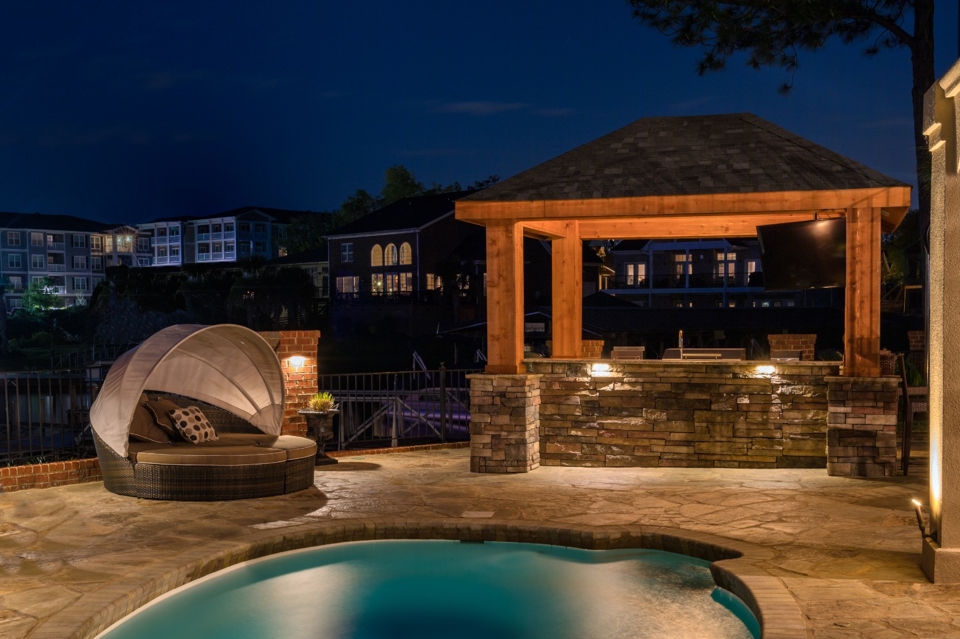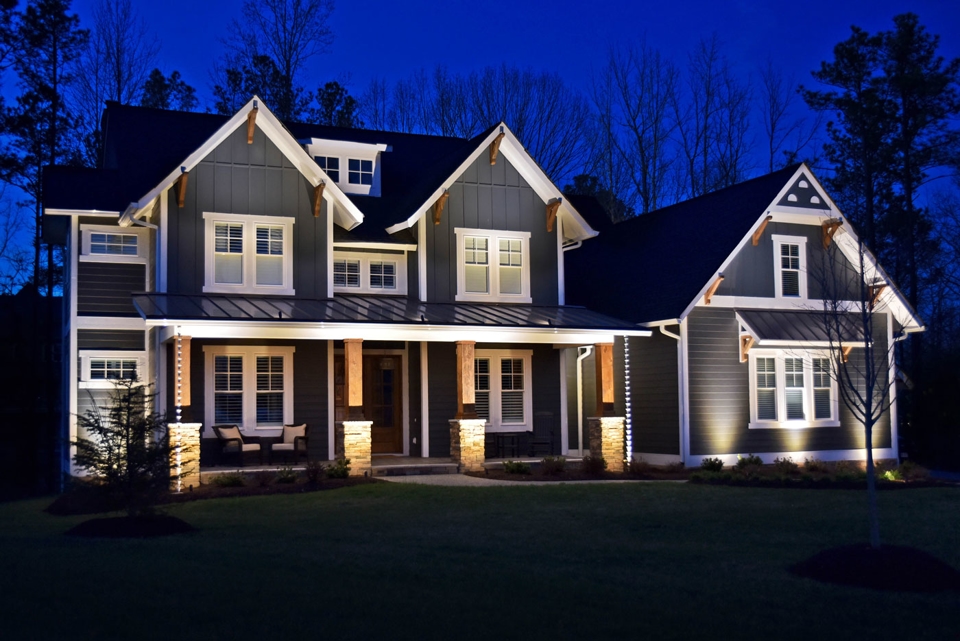LESS ENERGY USAGE, LESS GLARE, LESS RAZZLE–AND MORE DAZZLE
Our lighting designers approach each home as a blank canvas, drinking in the architectural details, landscape highlights and open spaces before crafting a lighting design that draws attention to the best aspects of all. The results reflect your desires–from creating a welcoming space for play, to announcing the majestic façade of your distinctive home.
As experienced lighting designers, we believe that less is more. In our installations, you won’t find many high-wattage lampposts (which can cause eye-irritating glare and produce inferior aesthetic results). Instead, we favor subtle lighting with less obtrusive fixtures. Multiple low-voltage lights can illuminate an area better than a pole light can–and with so much more panache. You’ll not only have far more attractive, better functioning light, you’ll enjoy lower energy bills.
IT’S NOT ABOUT THE FIXTURES–IT’S ABOUT THE EFFECT
Installers who do outdoor lighting as a sideline usually don’t understand the full importance of the light source. At Outdoor Lighting Perspectives, outdoor lighting is all we do. And we know the light itself is the most crucial element in any outdoor lighting design.
What you see is the light reflected off an object. Let’s say we’re looking at lovely stone façade. There may be dozens of tones of rich brown and gold in that stone. But if all those tones don’t exist in the light source, we won’t see them. The stone could end up looking flat and grey in the wrong light. And there are many “wrong lights.” All light sources are not created equal.
Every different type of bulb (referred to as a “lamp” in the industry) has different characteristics. Different light sources offer different color temperatures, a different Color Rendering Index (CRI), different lumens per watt, different bulb life, different degradation of light over time–the list of differences go on.
There are numerous light sources to choose from. Most often we use halogen lights for their ability to accurately portray color, to work well under a variety of outdoor conditions, and to provide long life as well as very affordable operating and replacement costs. However, there are occasions when we choose other light sources–for instance, when we want to warm the color of the façade or choose an extraordinarily long-lived bulb for an exceptionally difficult-to-access location.
It’s very important to select the right light source at installation because some fixtures are specifically manufactured to accept specific light sources. Types of bulbs are not always interchangeable.
Directional lighting
Placement is just as important as color and color temperature in any given lighting design. In placing lights, it’s important to consider which features define the property, the shape and textures of the surfaces to be lit, the shadows the light may cast, visibility and safety issues, maintenance issues, light spillage, and interaction with the surrounding landscape as seasons change and plants mature.
Up Lighting
Directing light upward from ground level dramatically highlights key architectural and landscape features. A different lighting angle than ever occurs naturally, up lighting stands out with a bold, unique look. Light-pollution concerns can be addressed by careful aiming combined with use of the proper lamps and fixture shields. When up lighting residential buildings, placement and beam width must be carefully addressed to prevent light spillage into bedroom windows.
Our lighting designers must also carefully consider landscape issues. Will growth patterns cause plants to block the lighting as they mature? Will the proximity of deciduous trees cause debris to block lights in the fall? Will snowfall patterns render lights ineffective throughout the winter? And so on.
Down Lighting
Illuminating an area or architectural element from above is often the best choice for safety, security or special effect. Lights shining down from above can illuminate a broad area, are difficult to tamper with, and are less likely to be hampered by landscape or weather concerns.
Bulb selection for down lighting involves practical as well as aesthetic and functional issues. For commercial applications, maintenance costs should be a major part of the equation. Maintenance issues should also be factored into residential installations. Homeowners opting to maintain their fixtures themselves may be better served by extremely long-lived lamps or a more accessible alternative to down lighting.
Wall Wash Lighting
Soft illumination accenting the texture of a wall surface can make a stunning aesthetic statement.
Area Lighting
Often, practical issues will require that a large area is illuminated without accentuating any specific object or feature. An area’s main purpose will play a major part in lamp and wattage selection. For instance, an area used for outdoor sports would require special attention to assure that depth perception is addressed, as some lighting can “flatten” perception. Areas used to host social gatherings might require a moodier light.
Spotlighting
A tree, a statue, a flag, a fountain or an architectural feature is often best highlighted by a spotlight. An important consideration in spotlighting is directing the light in a way that enhances the subject without creating undesirable shadows, glare or light spillage.
Shadowing
A skilled lighting designer can create magic with dark space as well as light. Causing a tree, a fountain or an architectural element to cast a shapely shadow against a wall can create enormous visual interest.
Silhouetting
Backlighting can be artfully used to show off boldly shaped details. Silhouetting is highly effective when an interesting pattern or unusual shape occupies the foreground.
Security Lighting
The elimination of hiding spots is but one concern when lighting to increase security. Attention must be paid to eliminating glare (for superior visibility). Security lighting should be strategically placed so the entire perimeter and all access points are properly lit–but that doesn’t have to mean the ugly, high-voltage lights that might come to mind when you think about “security lights.”
Pathway Lighting
Illuminating walking surfaces with light projected from knee height or above is both aesthetically pleasing and a great enhancement to safety. Special attention should be paid to areas with uneven surfaces or steps. Pathway lighting should be free from glare and allow depth perception. Pathway lights are particularly helpful when paths will be traveled by unfamiliar visitors and/or elderly individuals, when vegetation crowds paths or displays the potential to grow over paths unnoticed, and at homes where children or others are prone to leave objects strewn about. Pathway lights are important enhancements that can help prevent injuries and lawsuits.
Moonlighting
Shining a mercury lamp from a tree can create the illusion of moonlight. This is particularly desirable adjacent to buildings or on densely treed lots where natural moonlight may be blocked.
Water and Pond Lighting
Underwater lighting can add general illumination for both beauty and safety. Underwater lighting can also highlight underwater objects or murals and is lovely at a waterfall. Low-voltage lighting adds an extra dimension of safety for underwater lighting.
Step Lighting
Illuminating a step or group of steps can greatly improve visibility and safety. Step lighting can include lights on risers, LED lights embedded along step edges, lights under steps without risers, side lights or any combination thereof.






